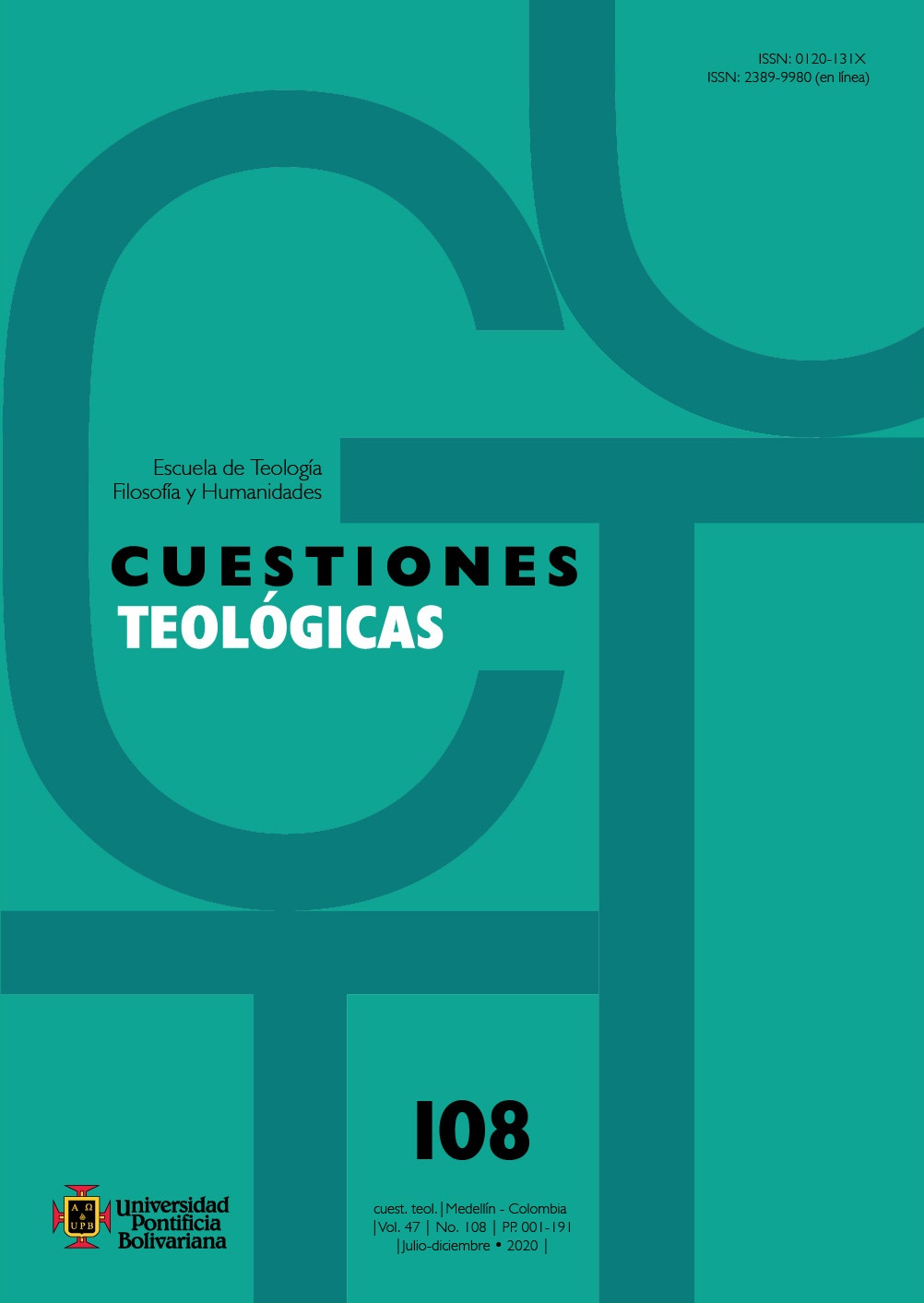Creation pushes and God with it: study of the argumentation in Rom 8,18-30
Main Article Content
Abstract
This paper puts forward an exegetical study of Rom 8:20-21 and attempts to explain “who it was that subjected creation to failure.” The exegetical discussion regarding the meaning of the expression “by the will of the one who subjected it” (διὰ τὸν ὑποτάξαντα) helps to determine whether the Pauline Theology of Creation in Romans is to be interpreted as eschatological or Christological. The announcement of the liberation of creation in Rom 8:21 also raises the issue of “its bondage to decay.” Why and for what purpose was creation subjected “in hope”? This research proposes a rhetorical approach to Rom 8:18-30 and reveals a crescendo (auxesis) in the groaning: the creation groans, we groan, and the Spirit groans. This crescendo involves the believers’ understanding of the effects of God’s salvific action through Christ. Paul uses the rhetorical figure of “personification” (prosopopeia) to identify human and non-human creation. Paul also relates this figure of thought with a play on words (groans / groaning) to show a paradox: in Christ, human suffering and God’s help to give birth to new life come together. Thus, Paul intends to demonstrate not only a “New Creation” in Christ, but also a new awareness: that of divine filiation.
References
Aletti, J-N., Gilbert, M., Ska, J-L. y de Vulpillières, S. (2006). Lessico ragionato dell’esegesi biblica. Le parole, gli approcci, gli autori. Brescia: Queriniana.
Aletti, J-N. (2012). New Approaches for Interpreting the Letters of Saint Paul: Collected Essays; Rhetoric, Soteriology, Christology and Ecclesiology. Rome: Pontifical Biblical Institute.
Byrne, B. (2010). “An Ecological Reading of Rom 8.19-22: Possibilities and Hesitations”. En D. Horrell et al. (Eds.), Ecological Hermeneutics: Biblical Historical and Theological Perspectives (pp. 83-93). London – New York, NY: T&T Clark.
Bruce, F.F. (1982). The Epistle of Paul to the Galatians: A Commentary on the Greek Text. Grand Rapids, MI: Eerdmans.
Bultmann. (1953). Theologie des Neuen Testaments. Tübingen: Mohr Siebeck.
Dunn, J.D.G. (1988). Romans 1–8. WBC 38A. Dallas, TX: Word Books.
Fernández Galiano, M. (1986). Esquilo: Tragedias. Madrid: Gredos.
Gibson, C.A. (2008). Libanius’ Progymnasmata: Model Exercises in Greek Prose Composition and Rhetoric. SBL. Writings from the Greco-Roman World 27. Atlanta, GA: SBL.
Gieniusz, A. (1999). Romans 8:18-30: “Suffering Does Not Thwart Future Glory”. Atlanta, GA: Scholars Press.
Granados. J.M. (2012). “Reconciliation in Col 1, 20: A Case of Polyptoton”. En F. Bianchini y S. Romanello. (Eds.), Non mi vergogno del vangelo, potenza di Dio (pp. 153-170). Roma: Pontifical Biblical Institute.
Grundmann, W. (1971). σὺν Χριστῷ in Paul. The New Dictionary of the New Testament, 7,781-793.
Harrington, D.J. (2000). Why do We Suffer? A Scriptural Approach to the Human Condition. Franklin, WI: Sheed & Ward.
Heath, M. (2002). Theon and the History of Progymnasmata. Greek Roman and Byzantine Studies, volumen 43(2), 129-160.
Jewett, R. y Kotansky, R.D. (2007). Romans: A Commentary (E.J. Epp, Ed.). Minneapolis, MN: Fortress Press.
Käsemann, E. (1974). An die Römer. . Tübingen: Mohr Siebeck.
Kennedy, G.A. (2003). Progymnasmata: Greek Textbooks of Prose Composition and Rhetoric. Leiden: Brill.
Lausberg, H. (1998). Handbook of Literary Rhetoric: A Foundation for Literary Study. Leiden: Brill.
Leese, J.J.J. (2018). Christ, Creation, and the Cosmic Goal of Redemption: A Study of Pauline Creation Theology as Read by Irenaeus and Applied to Ecotheology. London: T & T Clark.
Longenecker, R.N. (2016). The Epistle to the Romans: A Commentary on the Greek Text. Grand Rapids, MI: Eerdmans.
Moo, J. (2008). Romans 8.19-22 and Isaiah’s Cosmic Covenant. New Testament Studies, 54(1), 74-89. https://doi.org/10.1017/S0028688508000052
Mortara Garavelli. B. (1988). Manuale di Retorica. Milano: Bompiani.
Quintiliano.(2002). Institutio oratoria. The Orator’s Education, Volume IV. (D.A. Russell,Ed.). Cambridge, MA: Harvard University Press. DOI: 10.4159/DLCL.quintilian-orators_education.2002. https://doi.org/10.4159/DLCL.quintilian-orators_education.2002
Schaff, P. (Ed.) (1974-75). A Select Library of the Nicene and Post-Nicene Fathers of the Christian Church. Vol. 11: Saint Chrysostom: Homilies on the Acts of the Apostles and the Epistle to the Romans. Grand Rapids, MI: Eerdmans.
Schneider, J. (1971). στενάζω, στεναγμός, συστενάζω. The New Dictionary of the New Testament, 7,600-603.
Stenschke, C. (2017). Human and Non-Human Creation and Its Redemption in Paul’s Letter to the Romans. Neotestamentica, 51(2), 261-289. https://doi.org/10.1353/neo.2017.0014
Smyth, H.W.S. (1920). Greek Grammar for Colleges. New York, NY: American Book Company.
Spengel von, L. (1856). Rhetores Graeci ex recognitione. Vol III. Lipsiae: Teubner.
Watson, F. (2010). “In the Beginning: Irenaeus, Creation and Environment”. En D. Horrell et al. (Eds.), Ecological Hermeneutics: Biblical Historical and Theological Perspectives (pp. 127-139). London: T&T Clark.
Wilckens, U. (1978). Der Brief an die Römer: (Röm 6–11). Zürich: Benziger.
Wolter, M. (2014). Der Brief an die Römer. Neukirchen-Vluyn: Patmos.
Zerwick, M. (2011). Biblical Greek Illustrated by Examples. (J. Smith, Traductor). Rome: Pontifical Biblical Institute.






